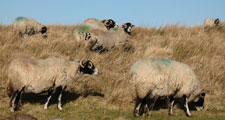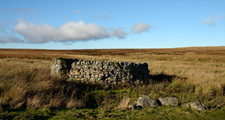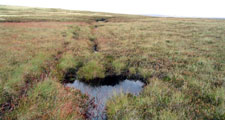Moorland Plateau
Land Management
Natural Features, Watercourses and Wetlands
- Protect natural rock outcrops, screes, stone bands and shake holes by preventing disturbance, infilling or stone removal. Where necessary fence vulnerable features against livestock.
- Protect gills and ravines from livestock to encourage regeneration of semi-natural vegetation including scrub and open woodland.
- Protect moorland flushes and pools – avoid drainage works, supplementary feeding and poaching by stock in their vicinity.
- Conserve blanket bog – avoid drainage works or physical damage and review burning practices and stocking levels.
- Restore damaged bogs and flushes by blocking grips and drains.
Moor and Heath
- Manage heather moorland to sustain and enhance biodiversity by adopting appropriate stocking densities and burning regimes.
- Restore heather moorland where it has been damaged by overgrazing by reducing stocking levels.
- Manage semi-natural acid and calcareous grasslands to enhance biodiversity by maintaining appropriate stocking levels and controlling the spread of bracken and rush.
- Manage access by encouraging the use of structured and seasonal paths to decrease pressure on fragile substrates and avoid disturbance to breeding birds.
Trees and Woodlands
- Promote natural regeneration of semi-natural birch, oak-birch and juniper woodlands along gills and ravines and in the moorland fringe.
Cultural features
- Protect archaeological features by avoiding overstocking and supplementary feeding on sensitive sites. Protect cairns, cup and ring marked stones and associated features from damage or removal.
- Conserve and restore moorland structures like sheepfolds, bields and bothies.
- Protect and conserve lead mining features – avoid physical damage, removal or infilling. Consolidate important structures and sensitively gate open shafts and adits taking archaeological advice.
Development
Energy and Telecommunications
- Avoid the siting of tall structures such as masts, pylons and wind turbines in the Moorland Plateau landscape.
- Where masts or pylons are needed site them in the moorland fringe close to existing buildings.
- New buildings should only be developed in exceptional circumstances – they should be sited to minimise visibility, be built of natural materials, and where possible designed to look like traditional moorland features – bields, bothies or sheepfolds.
Minerals and Waste
- Avoid damage to sensitive natural landforms.
- Avoid breaching skylines with extraction areas or storage mounds.
- Restore quarry faces to naturalistic profiles using restoration blasting.
- Restore quarries to semi-natural heathland, grassland, wetland and bare rock habitats using natural regeneration where possible.
Tourism and Recreation
- Manage access by encouraging the use of structured and seasonal paths to decrease pressure on fragile substrates and avoid disturbance to breeding birds.
- Facilities and infrastructure for tourism and recreation – paths, car parks, litter bins, signage and interpretation – should be provided only where absolutely necessary, and should be sensitively designed and low key to avoid exerting an urbanising influence on this wild and natural landscape.
Further Information
- Moorland Plateau Character Assessment
- North Pennines Strategy



